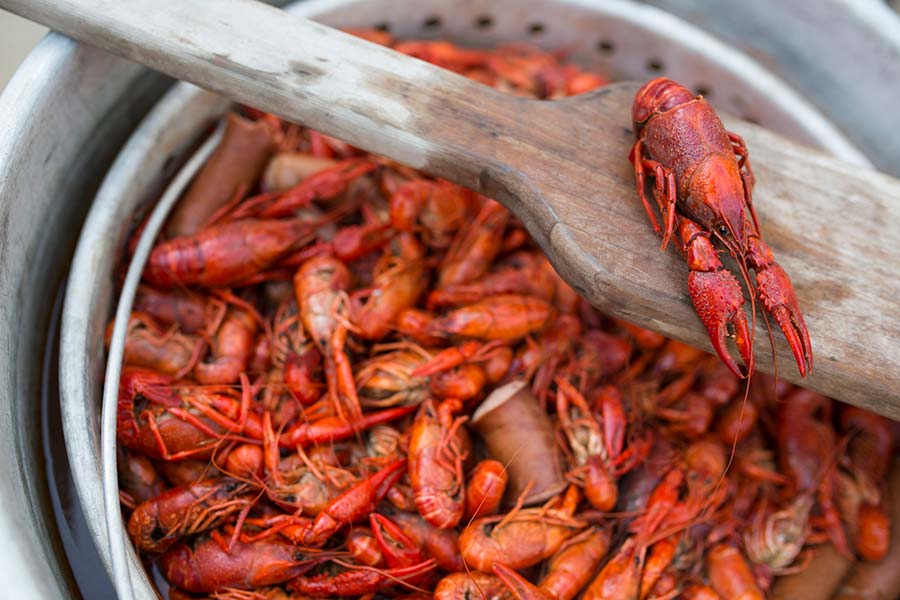
Crayfish are grayish when they are caught and turn red in color when they are boiled.
RIVERDALE – Dan and Lexie Genho catch and eat crawfish. Every year for the past decade Genho and some friends go to Strawberry Reservoir and catch about 1000 of them. Then they have a crayfish boil.

Crawfish are also called crayfish, crawdaddies, freshwater lobsters and mudbugs.
“We catch them and have a crawfish boil at night,” he said. “Then in the morning we have eggs benedict using crawfish as the meat.”
When he lived in Hyrum he caught them in Hyrum reservoir.
“They are aggressive in Hyrum,” he said. “I don’t know if it is the boats or what, but they’re mean.”
“There are four ways I catch them,” he said. “You can use traps and set them out, tie a chicken leg on a rope, use a nylon stocking and put a hot dog or liverwurst in it or you can find them under rocks and catch them with your hands.”
“When you catch them you have to have a net or bucket ready to put them in,” he added. “We’ve had a lot of fun doing the crawfish boils with groups over the years.”
It is illegal to transport live crayfish in Utah. They must be killed at the location where they are caught to prevent their being introduced into waters where they are not wanted.

“Utah crayfish prefer clear, fresh water, and rocky habitat, so do your fishing where there is a rocky bottom at depths of less than 20 feet,” a May 2019 Division of Wildlife Resources information sheet said. Bait can be chunks of meat, like liver, chicken or fish (no game fish). The fresh-water lobsters are attracted to odor.
The only gear needed is a strong string tied to a large piece of bait at one end. Throw the bait out into the water, wait a couple of minutes, pull it in smoothly and rapidly, and drop the bait with attached crayfish into a bucket. For faster action, add a heavy sinker.
“Keeping the catch clean is important to maintain freshness and flavor,” the DWR fact sheet said. “Thorough cleaning in the field may not be practical and it is not important if the crayfish body intact. If, only the tails are kept, contamination may be a problem.”
Another good reason for saving the body is the super-tasty meat in the claws and the nutritious, delicious internal organs and juices which can be used to flavor some dishes and soups.

The DWR instructions said the essential steps to preserve the texture and flavor of the precious meat are these:
- Keep the accumulating catch alive until the end of the fishing day.
- At the end of the day, discard any dead or mutilated crayfish and kill the keepers painlessly and quickly by stabbing each one firmly with a kitchen knife on the top, where the head joins the body.
- In a large pot with plenty of cold, clean water, wash the whole crayfish vigorously to remove surface dirt even if you only wish to keep the tails.
- Rinse thoroughly in another pot of fresh, cold water. Now remove the tails, if you want to.
- Pack whole crayfish or crayfish tails in alternate layers of ice and filter in a large, pre-chilled ice chest so they do not touch ice or stand in water.
- The chest should have a false bottom with at least four inches of space under it. Wood slats or hardware cloth nailed to 1″ x 2″ crossmembers will serve that purpose. Lay a plastic garbage bag on the bottom to prevent water from splashing upward, then place crayfish two or three deep.
-

A standard crawfish boils include andouille sausage, onions, potatoes and corn, boiled for 10 minutes before adding the crawfish, then cook for another three. Cover with plastic or newspaper, add two inches of ice, cover with another layer of plastic or newspaper, and then add more crayfish. Repeat until all your crayfish are packed. Top with ice.
- Leave the ice chest drain valve open until you are ready to load your vehicle. After the ice chest is packed, don’t open it again until you are ready to process the crayfish or transfer them to other refrigeration.
In contrast to the solitary sport of gamefishing, crayfishing can be a pleasant and productive group activity.

